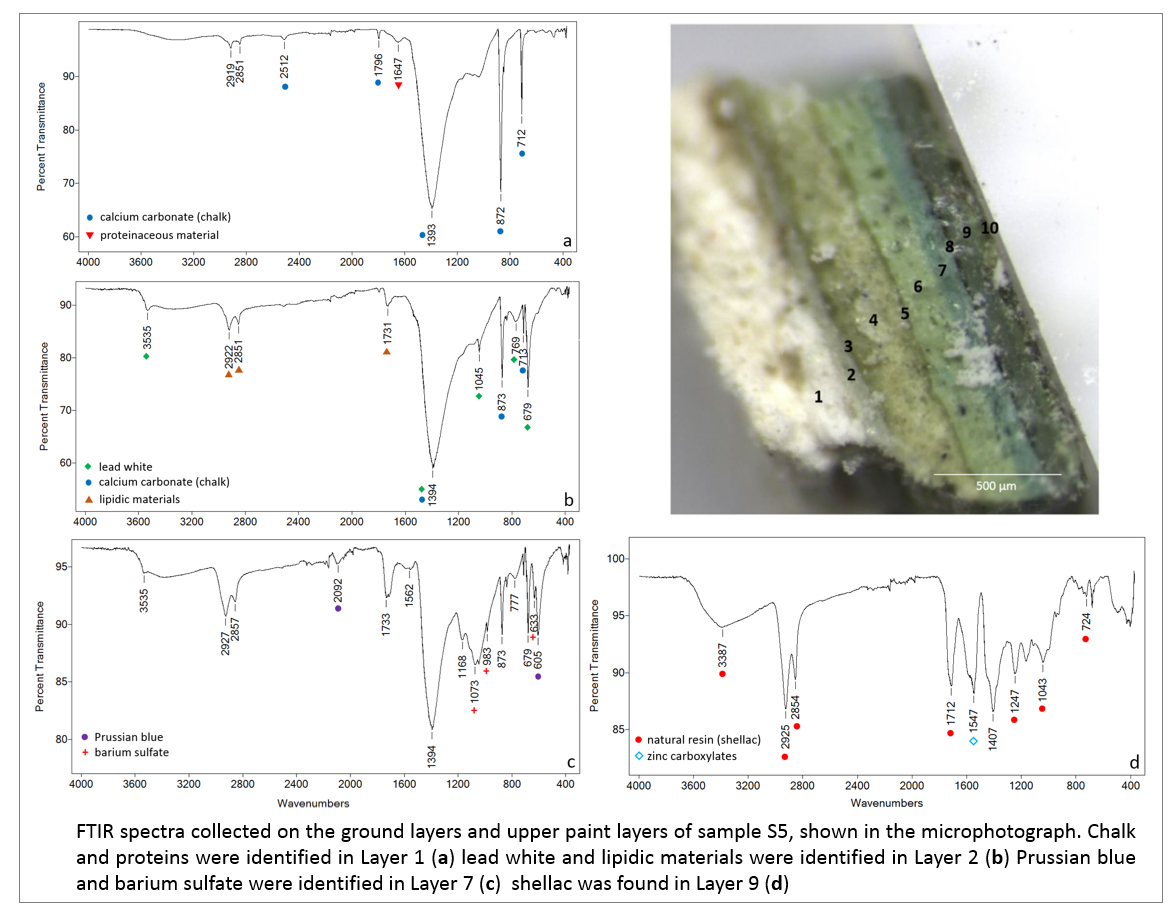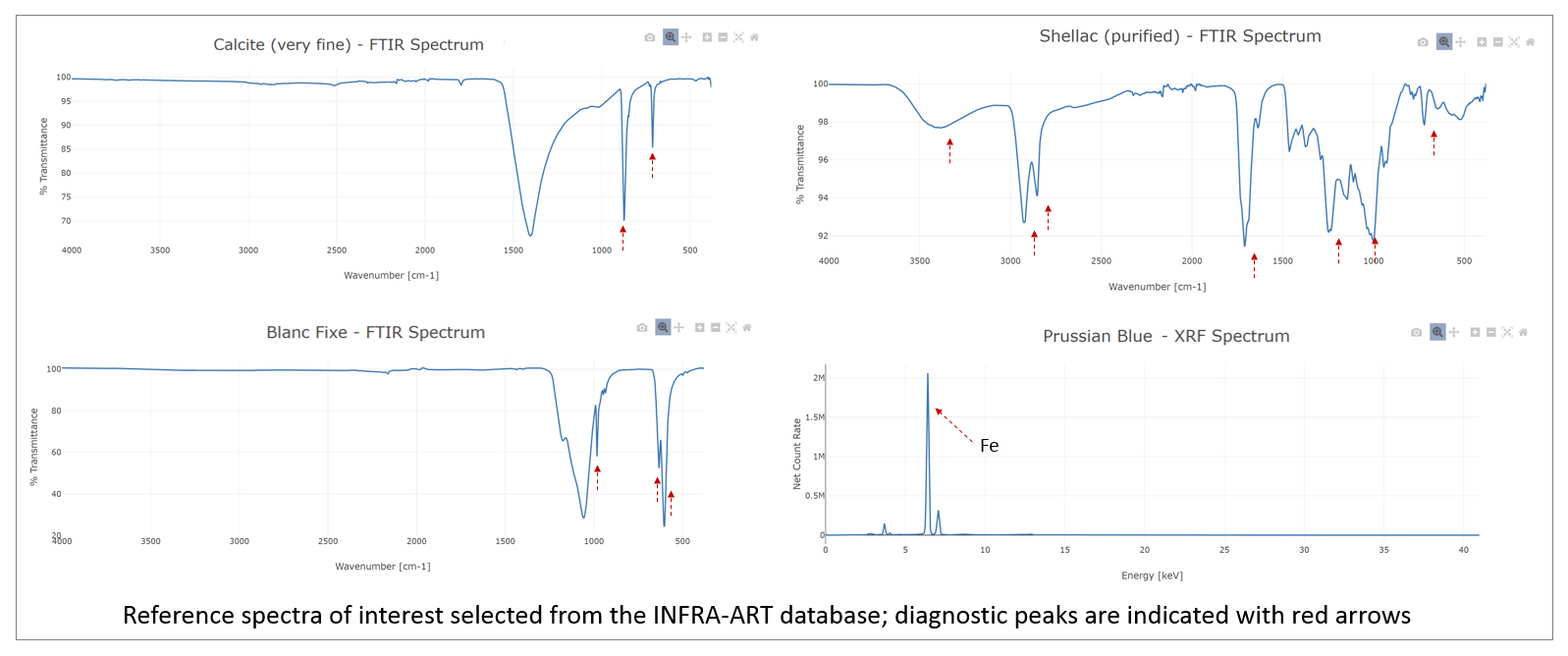The INFRA-ART Spectral Library was designed as a useful digital resource tool for researchers and other specialists in the field of heritage science, art history, conservation, and materials science that work with XRF, infrared (ATR-FTIR), or Raman spectroscopic techniques. The employed techniques (handheld XRF, ATR-FTIR, and fiber-optic Raman) are affordable scientific tools, widely used for the technical examination of works of art, both in-laboratory and on-site applications. These non-destructive analytic techniques allow detection and identification of specific chemical species contained in a sample, an extremely important aspect when dealing with complex and heterogeneous mixtures of organic and inorganic compounds - such as paint or archaeological samples.
Quite often in the process of characterizing and identifying cultural heritage-related materials, there is a need for reference data. In this regard, the development of databases with high-quality data of the pure substances used as artists’ materials is of utmost importance for the identification and characterization of unknown samples. Compared to other existing spectral libraries within the field of cultural heritage, INFRA-ART is an online open access resource that includes spectral data from complementary spectroscopic techniques, providing therefore both elemental and molecular data at the level of each sample.
Less experienced users can find below some general guidelines on how to efficiently work with the INFRA-ART Spectral Library. Some concrete examples of spectral data interpretation on real artworks/artifacts are also provided.
Case study: Roman wall paintings from the archaeological site of Ulpia Traiana Sarmizegetusa
Analytical problem discussed: Identification of green pigments
Employed techniques: ATR-FTIR, XRF
Publication: I.M. Cortea et al. (2020) First Analytical Study on Second-Century Wall Paintings from Ulpia Traiana Sarmizegetusa: Insights on the Materials and Painting Technique, in International Journal of Architectural Heritage, 14:5, 751-761. https://doi.org/10.1080/15583058.2019.1568614

Background: Green earths (or terres vertes) were among the most common pigments used by Roman artists. Green earths are green to blue-green pigments derived from the minerals celadonite and glauconite.
Analytical proposal: FTIR analysis was carried on several green pigmented areas. The registered FTIR spectra are dominated by the strong absorption bands of calcite. However, within the 3600 cm-1 region, some absorptions can be observed. A closer look within this higher region of the spectra highlights the presence of three peaks centered at 3601, 3557, and 3533 cm-1. Based on these findings users should start searching for the FTIR signature of different green earths. A quick search within the INFRA-ART database of FTIR data, under Earth pigments, using "green" as a keyword, will generate a list of existing entries. Users should focus on those pigments that show a similar signature in the upper region of the spectra. In the above image, we can see that the green earth from Cyprus displays the same peaks in the 3600 cm-1 region, characteristic for celadonite (Cyprus was an important celadonite deposit known since antiquity). On the other hand, Bavarian green earth, selected here for comparison, lacks these diagnostic bands.
The FTIR data are sustained by XRF analysis which showed higher Mg, Si, and K content, in detriment of Ca for the green investigated areas.
Note: FTIR data are not enough to carry out provenance analysis.
Case study: Pictorial layers of the case decoration of a Pascal Taskin harpsichord created in 1772
Analytical problem discussed: : Identification of painting materials (pigments and binders) used on the case decoration
Employed techniques: ATR-FTIR/ XRF on paint sample cross-sections
Publication: I.M. Cortea et al. (2020) Uncovering hidden jewels: an investigation of the pictorial layers of a 17th-century Ruckers-Taskin harpsichord, in Heritage Science, 8, 55. https://doi.org/10.1186/s40494-020-00401-3
Background: The instrument has an elaborated decoration with beautiful marine scenes on the case and lid interior and floral ornamental motifs on the lid exterior, keywell and soundboard. It is believed that the harpsichord was redecorated, most probably in the late 18th century or the beginning of the 19th century, due to degradations as well as to changes in style and aesthetic taste. The instrument has undergone several restoration interventions over time, poorly documented.


Analytical proposal: Sample S5 (shown above), taken from the bentside pictorial layer, has a complex stratigraphy, up to 10 layers being observed under microscopic examination. As can be seen in the cross-section, the top paint layers are in various shades of green. A typical white ground layer can be observed followed by a thinner grayish layer, most probably a priming layer.
FTIR measurements were carried at the level of ground layer/top paint layer, and then, after repeated mechanical scraping (with a hand scalpel, under microscope) on several other intermediate layers. XRF data registered showed high levels of Ca in the ground layer. The ratio between the Lα and Lβ lines of Pb suggests the fact that there is a lead-based preparation layer as well. For the paint layers high concentrations of Fe and Cu were observed, along some minor input of Cr, Si, K, Ca, Ba, Sr, Mn, Zn and As. The presence of Si, K, Ca and Sr, could correlate to the use of a green earth pigment. Mn and Cr could indicate the presence of a chromium oxide/viridian pigment. Cu (the most intense) in combination with As could infer the use of emerald green, a pigment introduced at the beginning of the 19th century. The high Fe input could also infer the use of Prussian blue as well. Green earth was known since antiquity, but the others are more modern pigments. Viridian was introduced in the second half of the 19th century, and the green chromium oxide had limited use as an artist's pigment, due to high manufacturing costs
Based on these observations we can narrow down the palette of possible materials used and try to correlate the FTIR data to the elemental signature obtained. For the ground layer we can assume a traditional recipe based on calcite or gypsum with some addition of animal glue. A quick search in the INFRA-ART database for calcite will give us almost a perfect match with the spectra registered on layer 1 that also shows some proteins. Within layer 2 FTIR confirmed the presence of lead white and highlighted the use of an oil binder. For the intermediate light-green paint layers the presence of an earth based pigment was observed. In layer 7 the Fe input is due to the presence of Prussian blue, easily identified within the spectra by its characteristic IR peak centered around 2090 cm-1. In layer 9 FTIR data highlighted intense absorptions typical for natural resins (strong C-H stretching vibrations, strong carbonyl stretch, several strong absorptions in the fingerprint region). Users could start exploring the database for FTIR data associated to various natural resins and compare their spectral signature. A good match is shellac.
At this point most of the XRF data is explained, with the exception of Ba and Zn. Some zinc carboxylates (degradation products) could be observed in layer 9, inferring the presence of a zinc-based pigment, most probably zinc white. The presence of barium could be due to barium sulfate also known as blanc fixe. A quick search for the FTIR spectra of this material in the INFRA-ART database will allow us, after a close examination of the spectra, to identify some diagnostic peaks, confirming our hypothesis.
Data interpretation: Registered FTIR data highlighted the use of a double ground layer based on a first layer of chalk and protein, followed by a second layer based on lead white bound in an oil binder. As indicated by combined FTIR and XRF data, initially the harpsichord had probably a pale green exterior, obtained with earth based pigments. The presence of barium sulfate, zinc white, Prussian blue, and a copper-based pigment (most probably emerald green) can be correlated with later interventions, all of these materials being introduced at the beginning of the 19th century. An intermediate sizing layer (isolation layer) based on shellac was found via FTIR analysis, associated with a restoration. The use of such size layers was documented in various historical recipes of the 19th century, shellac being used (alone or mixed with ammonia) to render the layer more water-resistant and obtain a smooth finish.
Note: Due to analytic limitations, we were not able to discriminate all the individual paint layers.